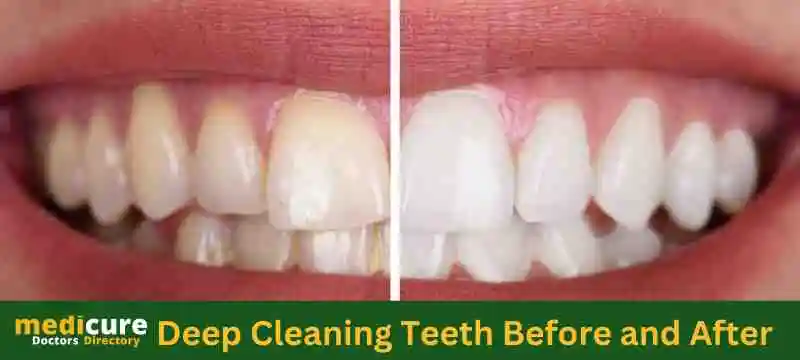MediCure

Deep Cleaning Teeth Before and After? A deep cleaning, so known as scaling and root planing, is a dental process that removes plaque and tartar from below the gum line. It is a more thorough cleaning than a regular dental cleaning and is used to treat gum disease.
Deep Cleaning Teeth Before and After
Gum disease is a serious condition that can lead to tooth loss and other health cases. It’s caused by a buildup of plaque and tartar on the teeth and epoxies. Plaque is a sticky film of bacteria that forms on the teeth every daytime. Tartar is hardened plaque that can build up below the gum line and irritate the gums.
Deep Cleaning Teeth Before and After
If plaque and tartar are not removed regularly, they can cause the gums to become inflamed and bleed. This is known as gingivitis. Gingivitis is the early stage of gum disease and is reversible with reasonable oral hygiene.
If gingivitis is not treated, it can progress to periodontitis, a more advanced form of gum disease. Periodontitis causes the gums to recede and form pockets around the teeth. These pockets can trap plaque and tartar, which can lead to further inflammation and infection. Periodontitis can also damage the bones that support the teeth, which can lead to tooth loss.
A deep cleaning is used to treat gum disease by removing plaque and tartar from below the gum line. This helps to reduce inflammation and infection and prevent further damage to the gums and bones.
Deep Cleaning Teeth Before and After

1. What to Expect Before a Deep Cleaning
Before your deep cleaning, your dentist will perform a thorough examination of your teeth and gums. This will help to determine the extent of your gum disease and develop a treatment plan.
Your dentist may also take X-rays to assess the damage to your bones.
If you have any other medical conditions, such as diabetes or heart disease, be sure to tell your dentist. This is because these conditions can make you more susceptible to gum disease and complications from dental procedures.
2. What to Expect During a Deep Cleaning
A deep cleaning is typically performed in two or more appointments. During each appointment, your dentist will clean one or two quadrants of your mouth.
Your dentist will start by using a local anesthetic to numb your gums. This will help to make the process more comfortable.
Next, your dentist will use a special tool to remove plaque and tartar from below the gum line. This may cause some bleeding and discomfort.
Once the plaque and tartar have been removed, your dentist will smooth out the roots of your teeth. This is called root planing. Root planing helps to prevent plaque and tartar from building up again.
After your deep cleaning, your dentist may apply a fluoride treatment to your teeth. This will help to strengthen your teeth and prevent tooth decay.
3. What to Expect After a Deep Cleaning
After your deep cleaning, your gums may be sore and bleed for a few days. You may also experience some sensitivity to hot and cold foods and drinks.
To help manage any discomfort, your dentist may recommend over-the-counter pain relievers, such as ibuprofen or acetaminophen. You may also want to eat soft foods for a few days.
It is important to continue brushing and flossing your teeth after your deep cleaning. This will help to prevent plaque and tartar from building up again.
Benefits of a Deep Cleaning
A deep cleaning can provide a number of benefits, including:
- Reduced inflammation and infection in the gums
- Improved gum health
- Prevention of further tooth loss and bone damage
- Fresher breath
- Brighter smile
How Often Do You Need a Deep Cleaning?
The frequency with which you need a deep cleaning will depend on the severity of your gum disease. If you have mild gum disease, you may only need a deep cleaning once a year. If you have more severe gum disease, you may need a deep cleaning more often.
Your dentist will recommend a deep cleaning schedule based on your individual needs.
Also Read;
Best Toothpaste for Receding Gums
Common FAQs about Deep Cleaning Teeth Before and After
1. Is a deep cleaning painful?
A deep cleaning can be uncomfortable, but it is not typically painful. Your dentist will use a local anesthetic to numb your gums before the procedure.
2. How long does a deep cleaning take?
A deep cleaning, also known as scaling and root planing, typically takes one to two hours per quadrant of the mouth
3. What should I eat and drink after a deep cleaning?
It is best to eat soft foods for a few days after your deep cleaning. You should also avoid hot and cold foods and drinks, as they can irritate your gums.
4. How can I prevent gum disease?
The best way to prevent gum disease is to practice reasonable oral hygiene. This includes brushing your teeth twice a day for two minutes, flossing your teeth once a day, and seeing your dentist for regular checkups and cleanings.
5. Can I smoke after a deep cleaning?
Smoking can irritate your gums and slow down the healing process. It is best to avoid smoking for at least a few days after your deep cleaning.
Conclusion
A deep cleaning is a safe and effective way to treat gum disease. It can help to reduce inflammation and infection, improve gum health, and prevent further tooth loss and bone damage.
If you have gum disease, be sure to talk to your dentist about the benefits of a deep cleaning.